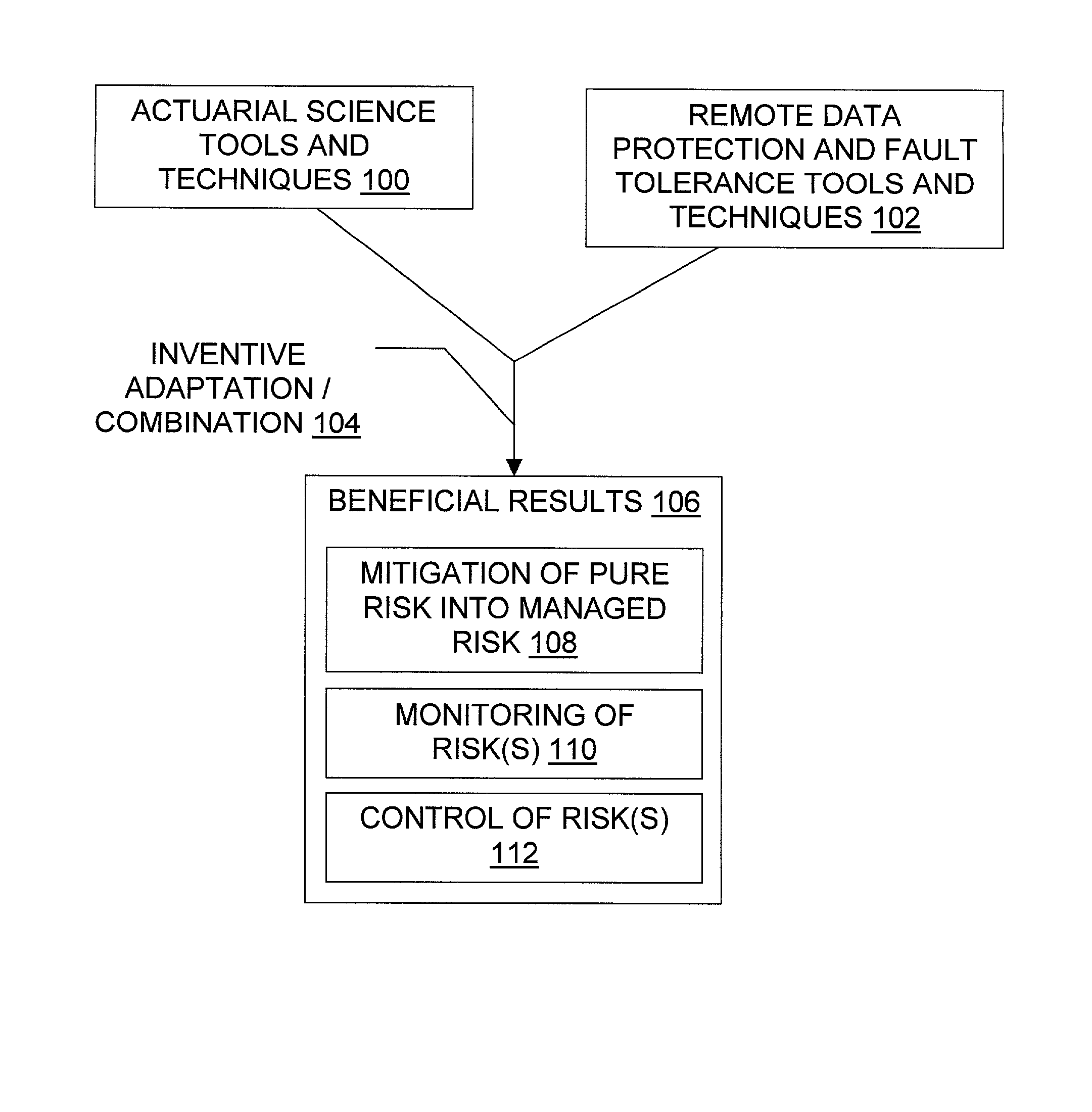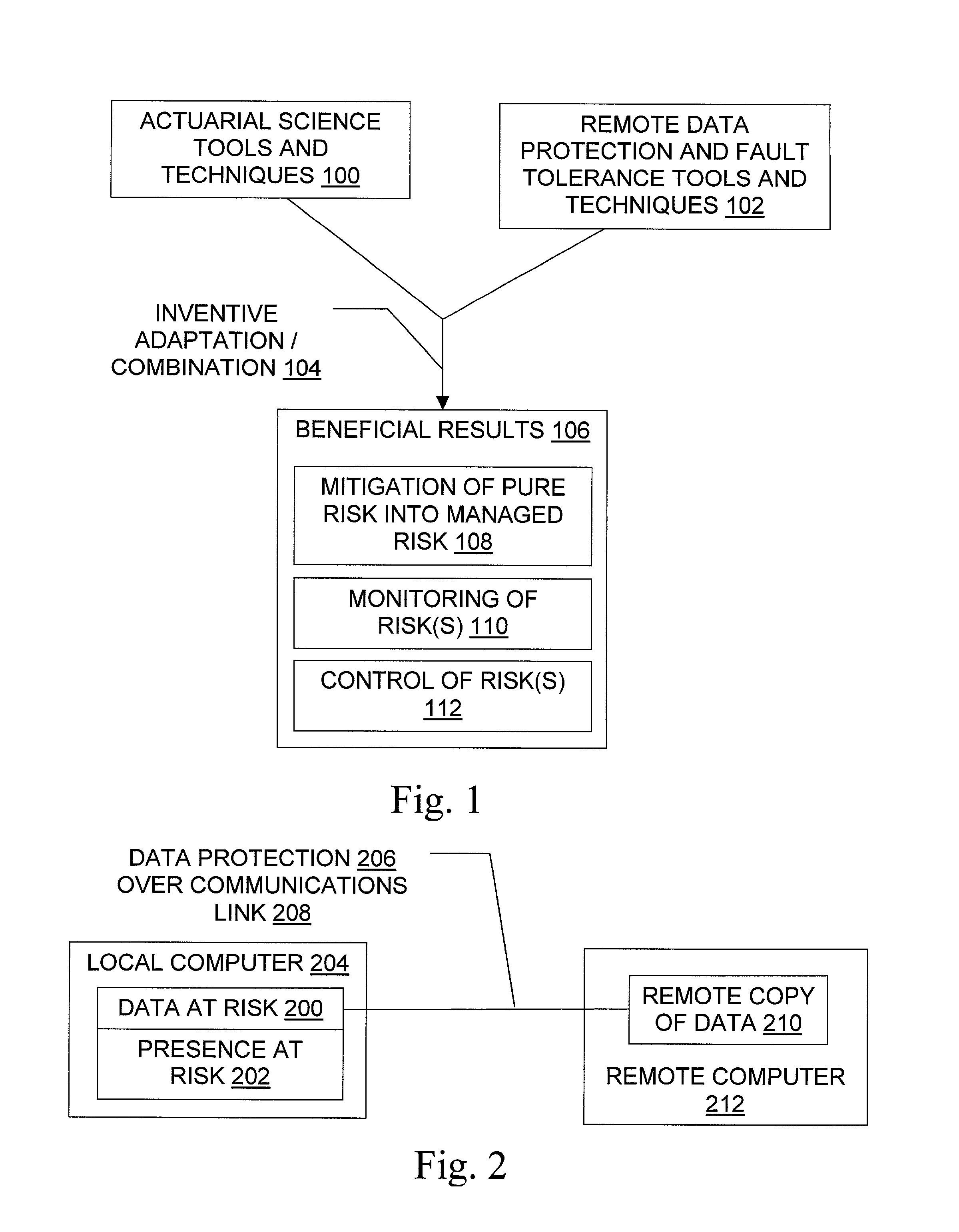Interruption of digital services can
pose long-term financial repercussions well beyond the initial financial losses due to interruption.
Traditional methods of insurance are not properly structured to address the volatile risk involved in the transitional business methodologies employed in the emerging financial and
business environment.
Normally this is the loss of a physical tangible asset; in the new economy this could be the loss of data or the loss of users due to
system downtime.
Traditionally, indirect losses result from the loss of use of property.
For instance,
ripple effects in a business that has experienced critical down time may be viewed as indirect losses.
Pure risk exists when a loss or an unchanged state occurs as only as the result of an
event based on chance.
If one may
gain as a result of chance, the situation is described as a speculative risk.
In the new economy, data itself is normally not insured because it is subject to pure risk.
That is, the chance of data damage or
data loss is viewed, as a practical matter, as being so unpredictable that the risk to data is a pure risk.
Providing insurance for pure risks is not traditionally considered a good business model for an insurance underwriter.
The speed of transactions in this environment and the variable value per transaction have introduced a new set of risks that are somewhat nebulous and hard to define.
In the new economy, hazards are also often localized rather than spread out.
However the law of large numbers assumes that a large group of businesses or people will experience a series of unrelated events or risks at different times in different places.
This rule does not account for the concentration of relatively large assets and related interests within relatively small geographic location.
For instance, in a web-based high speed transaction environment a significant portion of a large organization's potential loss or
gain may depend on a single network
server.
Further risk concentration issues are created by the
mass deployment of shared data centers and web hosting facilities.
For example, if a catastrophic event occurred at just one
data center owned by a large
data center / web hosting / E-commerce facility, then the valuations of many of the "hot" new economy companies would tumble, their critical transactions would cease, and significant ripples could be felt throughout the economy as a whole.
The undefined risks and concentration issues related to an electronic economy makes the cost of losses and the reserves into something viewed, as a practical matter, as pure risk.
Although these criteria represent the ideal in practice, insurance is written under less than ideal conditions.
However, insurance ventures that depart too far from the ideal are likely to fail.
It would be unfair to combine them in the same insurance
pool and charge each insured the same premium rate based on the combined losses of the
pool.
If such an attempt were made, the rate developed would cause the owners of
brick homes (less susceptible to loss) to pay too high a premium and the owners of wooden structures (more susceptible to loss) to pay too low a premium.
When significant unfairness, or subsidization, occurs, the insurance
pool does not fairly transfer the costs of the losses.
This situation cannot continue in a competitive insurance market.
That is, assume some buildings in an insurance pool were especially susceptible to fire damage because they were located near a gas
station.
Charging all insured in the pool the same rate would be unfair.
The non-explosion-prone exposures would be paying too high a premium and would soon
drop out of this insurance pool.
But this reasoning does not apply as well in a digital environment.
If the gas
station were to blow up it is unlikely that both buildings would be damaged equally.
Furthermore it is even more unlikely that all of these buildings would be equally damaged as they could be at different angles to the blast and at different relative differences.
Unlike a group of one thousand off-line stores, these same one thousand online shoe stores may all be in one large Internet hosting site that may experience the same physical or technical disaster.
Otherwise, much undesirable courtroom litigation to determine whether or not a loss has, in fact, happened would result.
Thus, an individual can be insured against the loss of a house as the result of a fire, but cannot be insured against its loss as the result of its being haunted.
More realistically, health insurers often limit payments for
mental illness because of the difficulty of determining the onset, presence, or absence of the covered condition in many cases.
Termite damage is usually not insured by property insurance contracts because it is often too difficult to determine the time when the loss occurred and the extent of damage.
The loss of a loved pet can cause a family much grief, but such discomfort is not easily measured.
Also, a morale
hazard may be created when pets are insured for substantial sums.
Insurance operates most successfully when the potential damage caused by a peril is severe enough to cause economic hardship.
Insuring inexpensive items, especially if losses are frequent, would result in premium charges equal to or greater than the potential damage, which of course makes such insurance unattractive.
A gas
station that has its pumps break may lose one day's business, but a
web site with a downed
server for one day may lose its users for good.
As used here, a catastrophic loss
exposure is "a potential loss that is unpredictable and capable of producing an extraordinarily large amount of damage relative to the assets held in the insurance pool."
Despite the common convention of identifying any extraordinarily large loss as catastrophic, defining catastrophic loss from an insurance standpoint may be difficult because the definition is relative.
A catastrophic loss is one that is extraordinarily large relative to the amount of property or number of
exposure units in an insurance pool.
Insured catastrophes occur when a single event (peril) can affect a large percentage of the loss
exposure units in the insurance pool.
Another way of stating this definition is that catastrophic loss potential exists when insured losses are not independent.
That is, catastrophic loss potential exists when a loss to one exposure unit implies a likely loss to the other exposure units.
Catastrophic losses from natural disasters normally have two general characteristics: (1) They are limited in geographic
impact, and (2) they are not accurately predictable.
Thus, earthquakes, volcanoes, and floods have catastrophic loss potential.
As business and individuals are rapidly changing their deployment and uses of electronic tools, the types and limits of losses are not conventionally predictable across a large group.
As previously discussed, this does not necessarily work effectively with data and online presence.
The basic assumptions and methodologies employed by practitioners are flawed when applied to the digital world.
As the nature, use, and value of data is changing outside historical bounds and parameters, historical practice is conventionally another area of
weakness in calculating units of exposure related to
data loss.
But traditional approaches do not have the same statistical value as in traditionally insured assets, due to the conventionally undefined factors outlined above.
In a conventional environment data insurance can only be reasonably be calculated (if at all) based on a Pure Premium Method or variant thereof, because the Loss
Ratio Method requires historical data to be calculated.
In particular, in the above formula the calculation of pure premium, fixed expense, and variable expense factor are flawed because of a fundamental lack of definition of the rate of change, variance of change value of change, concentration, and extraneous local environmental factors.
As previously discussed concentration issues may invalidate this basic principal of insurance.
Ironically, by providing the combination 104 of an insurance vehicle with a remote data protection technology, a concentration issue can be created through negligence and therefore invalidate or jeopardize applicability of the law of large numbers.
There is no perfect way 102 to protect data and related change.
The possibility of a bad
recovery may lead to a requirement for external
verification of received insured data 200.
As discussed above, there is always a local
environmental risk related to any facility to which the protected data is exposed.
 Login to View More
Login to View More  Login to View More
Login to View More 


